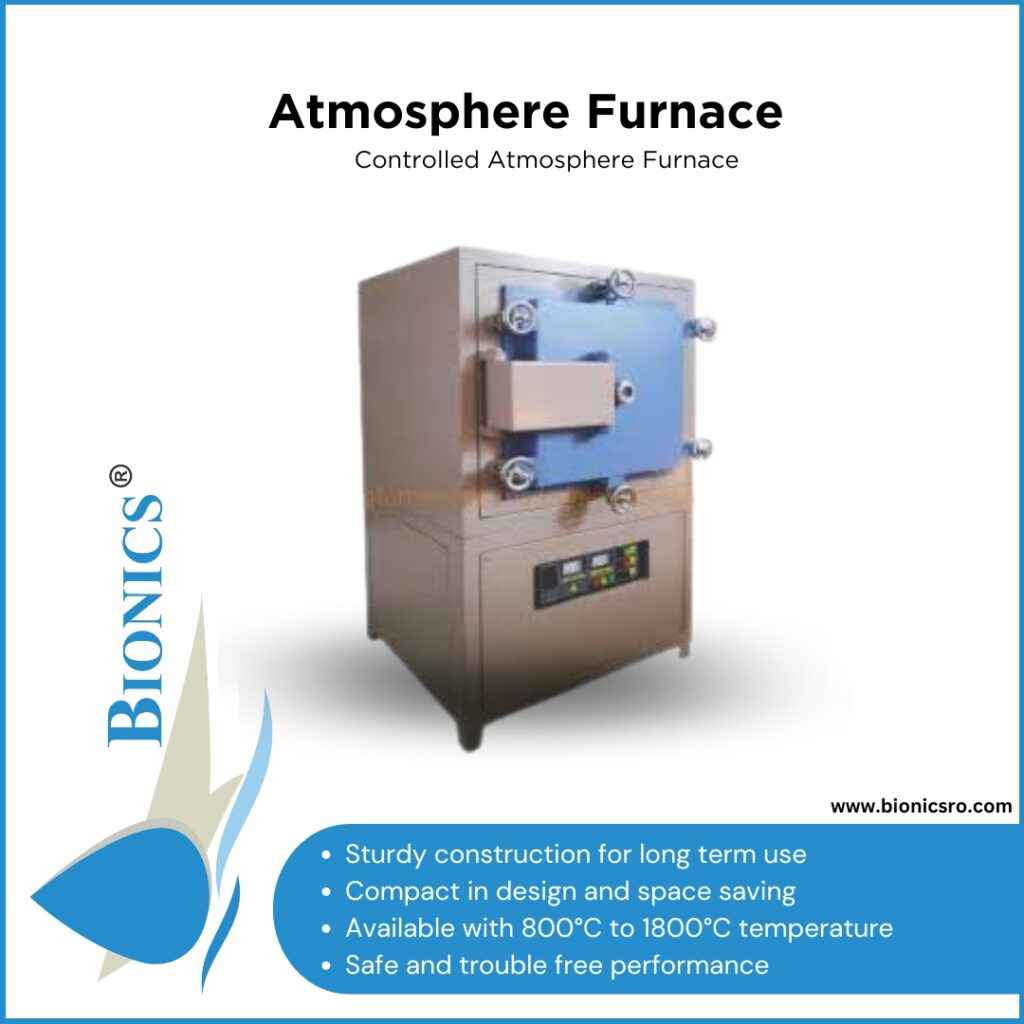Stay up to date
Stay up to date with our monthly e-newsletter
* We will never share your email address & you can opt out at any time, we promise.
Heat treatment processes such as bright annealing, sintering, and carbonitriding are very important in the manufacturing of high-strength alloy components used in industries such as aerospace, automotive, petrochemical, and nuclear power. This process requires a controlled atmosphere, which may involve inert gases such as nitrogen, helium, argon, endothermic mixtures, or hydrogen. Poor furnace control affects alloy quality with associated financial and safety implications.
Bionic Consortium is a major Indian manufacturer that engages in various types of atmosphere furnaces having different ranges of working temperature as well as different sizes for their heating zone(s).

The atmosphere furnace is a special heating unit that can control the atmosphere surrounding the material to be heated. These materials can be suited to different ones and densify the product, thus improving its performance. This heating system is usually used during an entire material production process, while other times it may only be performed on it at the final stages, depending on what will fit best to a given manufacturer. The atmosphere furnaces are mostly used in industrial labs for carrying out heat treatments under controlled environments where argon (Ar) or nitrogen (N2) is employed to create an inert atmosphere. So there would be safety systems built around hydrogen gas so that it does not get blown up during usage.
Atmosphere furnaces create vacuum up to 0.1 MPa using a rotary vane oil-filled vacuum pump first, then they purge inert gas (argon or nitrogen gas) to avoid the formation of oxides on metal surfaces before these furnaces are used for operations like annealing, brazing, and heat treatment of material that might oxidise readily.
The major purpose of atmosphere heat treatment furnaces is to provide an environment where various kinds of heat treatment experiments can be conducted at controlled temperatures with specific atmospheres for individual projects. The tightly sealed, controlled environment guarantees the success of projects since the right atmosphere should prevail within them. For a given project’s success, a precise mixture of gases being another key element in an atmosphere furnace necessitates correct measurement made for each particular gas concerned. The gases are mixed again in another chamber and then introduced into the furnace chamber. For this reason, this separate chamber should be kept free from external air to avoid disturbance of the gaseous mixture that may result in futility of the entire project.
An atmosphere furnace is a type of high-sealing furnace for maintaining environmental stability and pressure control. In addition, it is equipped with an atmosphere control system that has the capability to adjust by itself so as to maintain the composition and stability of the environment in which it operates. Two types of atmosphere furnaces can be identified: muffle furnaces and non-muffle furnaces. With indirect heating being used by muffle furnaces, non-muffle furnaces tend to separate flame or electric heating elements from gas through flame radiation tubes. They also contain explosion preventive devices so that explosions generated due to the mixing ratio of reducing gas and air are limited. The purpose of an atmosphere furnace is to induce artificially prepared atmospheres into predetermined temperatures set for specific heat treatment such as: carburizing, carbonitriding, bright quenching, annealing, normalizing etc.
Bionic Consortium is a major Indian manufacturer that engages in various types of atmosphere furnaces having different ranges of working temperature as well as different sizes for their heating zone(s).
The vane vacuum pump-inert gas furnace comes with features like;
The PQ Atmosphere muffle furnace is not designed for use with toxic or explosive gases if there are no safety controls and supervision. Over time, the refractory ceramic may develop small cracks on its surface, which can be repaired by applying an alumina coating. The ultimate vacuum level is roughly 20000 Pa using a hose barb connection. Vacuuming here is meant for pre-vacuuming the chamber before introducing inert or protective gases. For special vacuum level requests, professional vacuum furnaces should be purchased.
During the heat treatment process, the atmosphere can either act as a carrier for the main elements or shield parts from exposure to high temperatures and air. When used as a carrier, it dissolves surfaces, thereby changing their properties, which enhances activities like surface hardening. Alternatively when used as protective one, it prevents chemical reactions between parts and harmful substances. Inadequate protection may result in quality issues, affect performance levels, lead to financial losses, waste time, and even cause dangerous situations through improper controls that damage both the furnace itself and people around it.
There are other types of heat treatment processes that need controlled atmospheres to function properly, such as those requiring an inert environment or hydrogen environment:
Carbonitriding: In carbonitriding, carbon and nitrogen atoms are diffused into the surface of a metal, thereby increasing its hardness; nitrogen addition is typically done with endothermic gas.
Tempering: Depending on what kind of metallic compound needs sintered together depends upon whether you should do it without air around them (such as using argon) or with some sort of shielding gas like hydrogen, which helps keep oxygen away from things while they get heated enough so that their atoms can come close enough together for bonding to occur among them.
At Bionics Consortium, we have spent decades making high-quality industrial ovens and quenching tanks as well as furnaces precisely built for any industry that needs reliable heat-treating solutions.
Precision control, repeatability, and precision are the most important aspects of heat treatment processes at Bionics Consortium Special Furnace. They use many different skills and complex designs in their furnaces. In addition to four models that allow for controlled atmospheres, which provide tailored solutions for each customer, there is a range of sizes available to meet specific client requirements.
Different areas utilise atmosphere furnaces, such as the mechanical manufacturing industry, metal processing industry, or ceramic manufacturing industry. It can improve both quality and quantity while reducing cost and energy consumption correspondingly. In simple terms, an atmosphere furnace refers to equipment used for carrying out material heat treatment under certain environments; it comes in various types with different features, thus finding wide application across many sectors of the economy.
Stay up to date with our monthly e-newsletter

Bionics Consortium Pvt. Ltd. is a premier Indian company specializing in the manufacturing, supplying, and exporting of laboratory and scientific equipment, available in both standard and custom designs.
Copyright © 2024 Bionics Consortium Pvt. Ltd – all Rights Reserved.